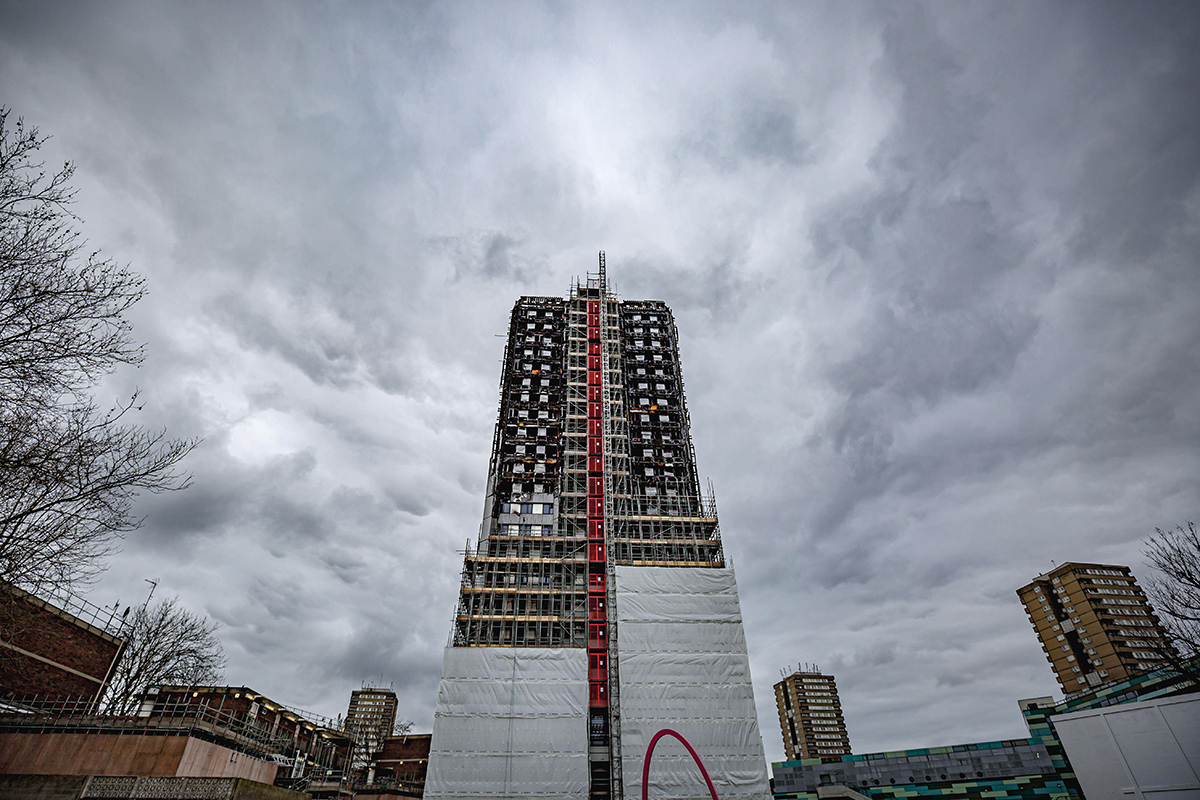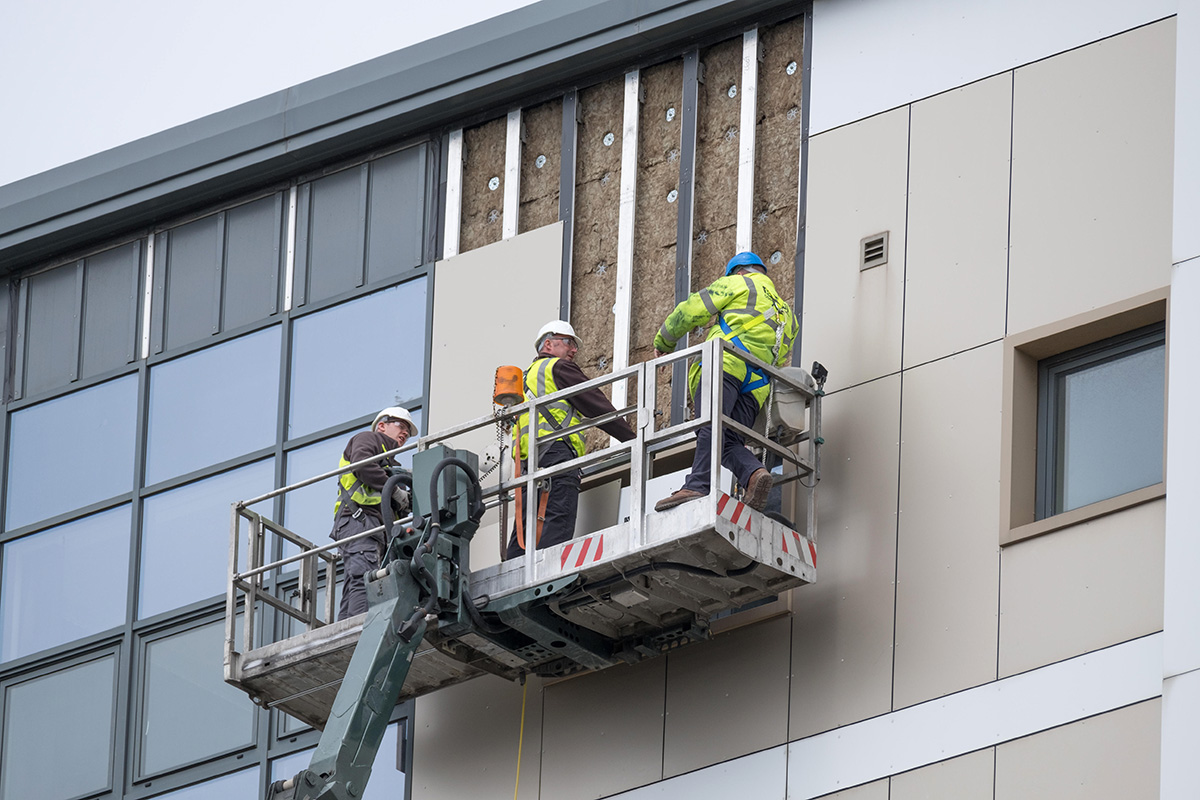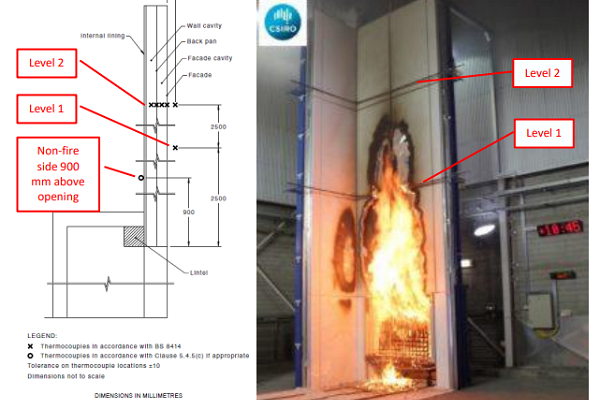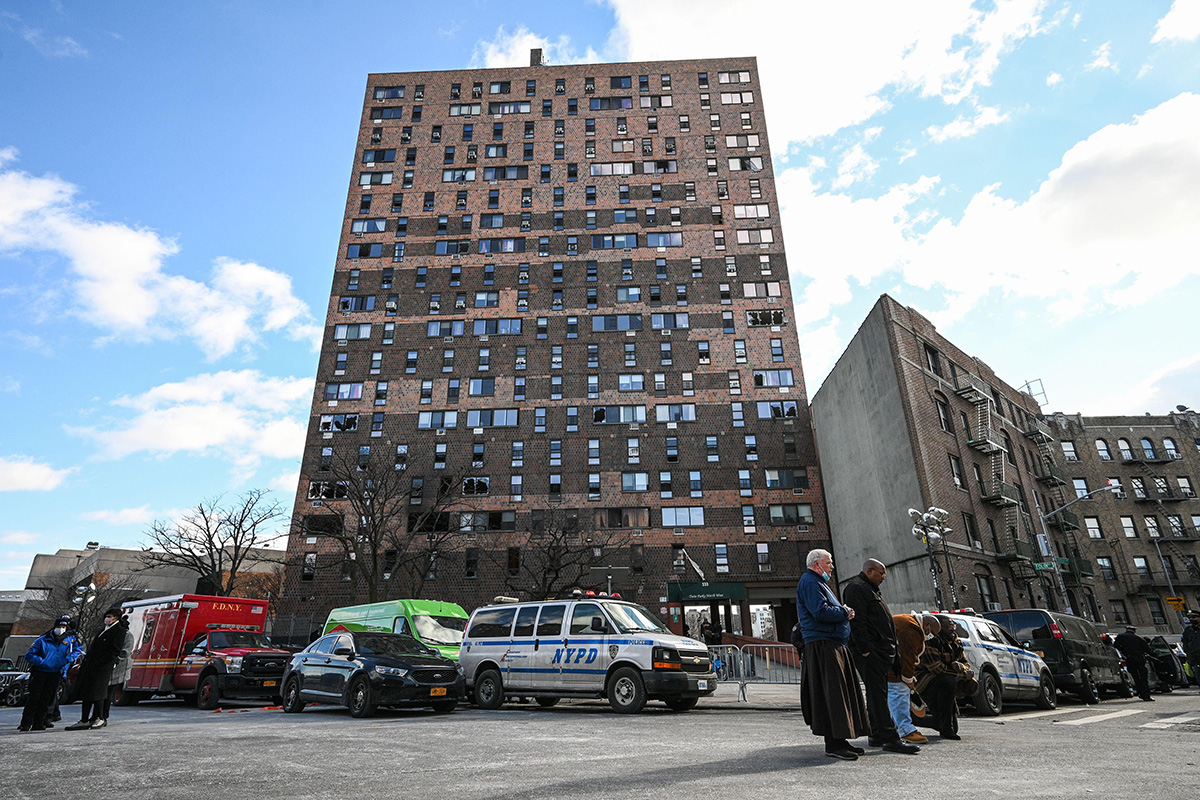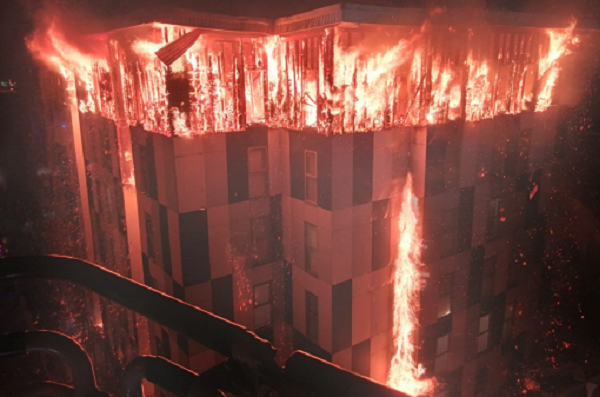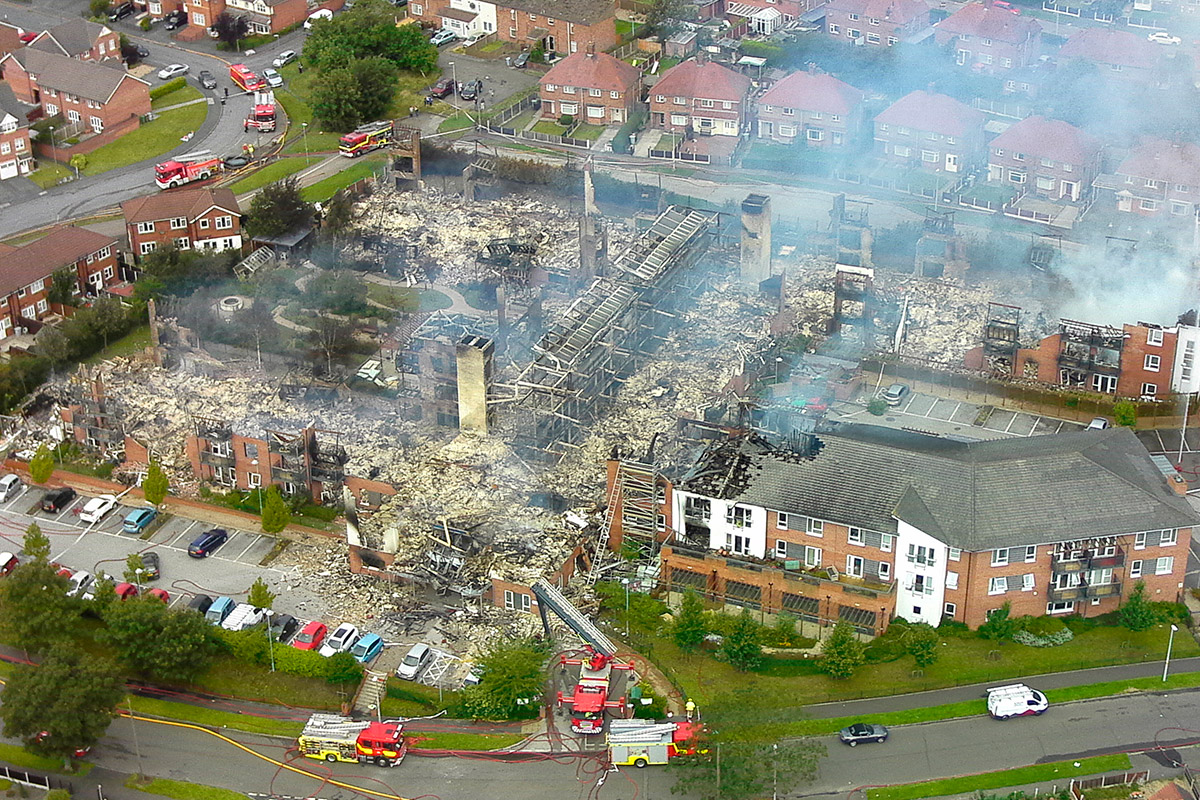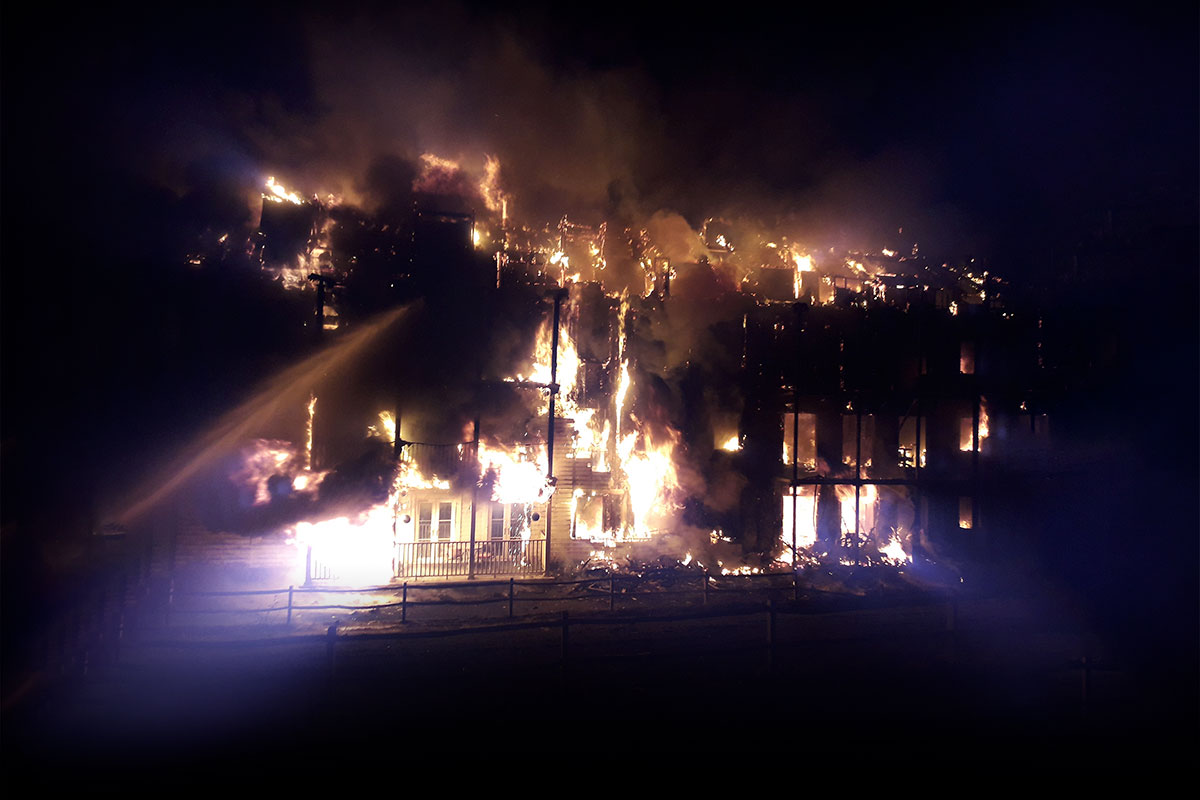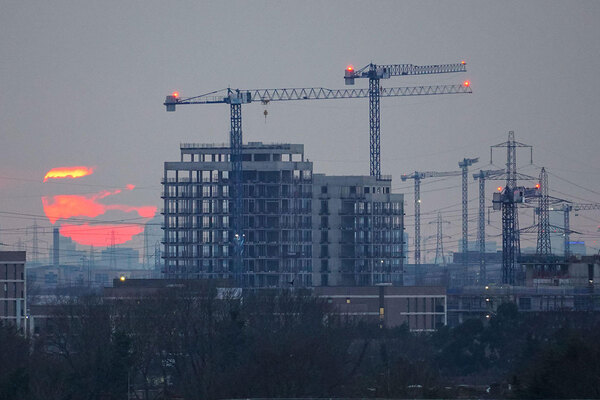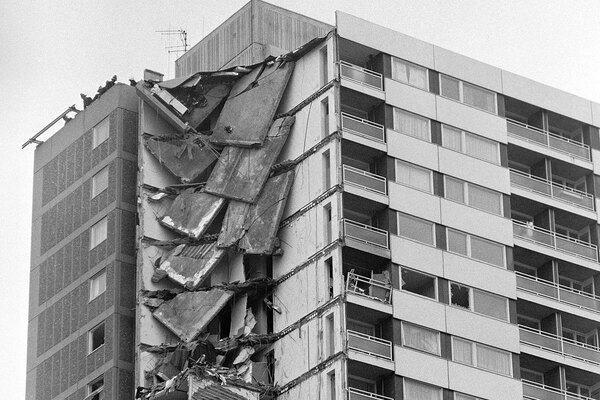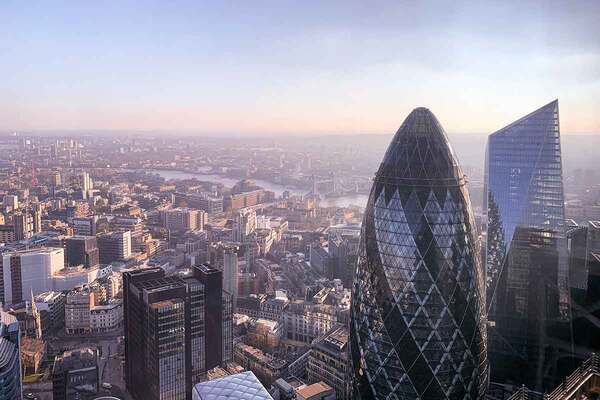Grenfell five years on: could it happen again?
After the Grenfell Tower fire, politicians of all colours committed to ensuring such a disaster would never happen again. But, five years on, has this promise been kept? Peter Apps investigates
Five years ago this week, the country awoke to heart-stopping images of Grenfell Tower on fire.
As 24-hour news footage showed live pictures of the wrecked tower and devastating images of residents waving white T-shirts from windows, it felt like there was a rare moment of national consensus: this could never be allowed to happen again.
But, five years on, the urgency which followed the disaster has waned. Updates from the public inquiry have long since dropped out of the mainstream media and, at least for those not impacted by its aftermath, the fire feels like a long time ago.
When I speak to people who are not following the detail of the building safety crisis that has gripped Britain in the five years since the blaze, there is an automatic assumption that the problems have been dealt with; that whatever it was that caused a tower block to be engulfed in flame with a quarter of its population trapped inside has been fixed. Surely we would not gamble with a repeat?
The truth is more disturbing. Many of the defects which led to the Grenfell fire still exist in other buildings. And our overall fire strategy has not shifted sufficiently from the total faith placed in telling residents to “stay put”, a tactic that came apart with devastating consequences in west London in 2017.
As the five-year anniversary of that terrible night approaches, Inside Housing asked a selection of experts a simple question: could it happen again?
For some, particularly those in government, comfort is taken in statistics. The number of fires and fire deaths in the UK are at a historic low, and continue to fall. Fire services attended 48,664 fires with 237 fatalities in England in 2020-21, down from 115,176 fires and 755 deaths in 1981-82. The trend has been one of almost uninterrupted decline, with the exception of 2017, which included the deaths at Grenfell. Surely this shows we are getting something right?
But these figures can be misconstrued. They tell us a lot about low-consequence, high-probability incidents, and nothing about the threat of a low-probability disaster with catastrophic consequences.
To learn about events like Grenfell, there is little we can do other than look at the event itself and ask if it could be repeated.
Thanks to the diligent work of the Grenfell Tower Inquiry, it is now possible to do that with some clarity.
We know that a normal kitchen fire on the fourth floor of the tower was able to escape the flat in which it started through a newly installed window with major defects, which meant it offered little resistance to the flames.
These flames then ignited an external cladding system made of violently combustible plastic products, spreading fire first up the building and then progressively down and around it.
As the blaze broke back into flats through windows, it started a series of flat fires. Internal failures in the building allowed smoke and flame to travel through lobbies and eventually the single staircase – trapping residents inside and hindering efforts to save them.
This was due to numerous issues, but, most importantly, a staggering number of flat entrance doors were missing legally required ‘self-closing’ devices. This meant that when they were opened as residents fled their burning flats, they did not swing closed.
Finally, there was a critical failure to attempt to evacuate the building once the fire started to get out of control. Residents were told to stay put for more than an hour-and-a-half after the fire started. By the time this advice was changed, the conditions were too severe for many to escape. This made Grenfell an outlier in building fires around the world, with its death toll of 72 far exceeding similar blazes from Milan and Chechnya, to Dubai.
Putting all of this together, we have a list of basic flaws: dangerous cladding, broken fire doors and the lack of an evacuation plan. What, then, has been done to address these at other buildings?
Cladding
Cladding is where the majority of political and media attention has been focused – with good reason. It is also the only area which has attracted significant public funding, with around £9bn committed to various programmes of cladding removal.
The results, however, are mixed. Immediately after the fire, in spite of independent advice that there was a range of dangerous products on other buildings, the government’s remediation efforts focused solely on aluminium composite material (ACM) cladding systems, the type used on Grenfell Tower.
It also limited its initial focus to buildings above 18 metres in height, a relatively arbitrary threshold that has a historical link with the length of firefighters’ ladders.
In this narrow area, it has made progress. The latest in a series of monthly updates shows 94% of the 486 buildings over 18 metres in height with dangerous ACM systems have either started or completed the remediation work.
Among these, 318 have fully completed the process and 428 (88%) have had the cladding stripped from their walls. Only one still has no clear plan for remediation.
While it has taken a long time – with two government pledges to complete the work (first June 2020 and then the end of 2021) missed – the fact that so many blocks have had this cladding removed is undoubtedly welcome news.
Tests shown to the public inquiry – including one held secretly by central government since 2002 and those held by the manufacturers of the ACM used on Grenfell since 2004 – speak to the devastating fire performance of this material.
But tall buildings with ACM cladding have only ever been the tip of the iceberg when it comes to building safety in the UK.
What about other types of material? Testing shows a seriously poor performance for high-pressure laminate (HPL) (thin wooden boards bonded together with glue), which failed the UK’s official test almost as quickly as ACM in one widely used combination. There have been numerous fires which demonstrated this risk outside of the laboratory.
Systems which use various forms of polystyrene as insulation are also common on high-rise buildings, with tests from Australia suggesting a fire performance comparable to ACM (pictured below). The government has refused requests to run an official test on this material in the UK, despite the fact that it has been linked to deadly fires globally.
Progress identifying and remediating buildings with dangerous cladding materials of this and other forms has been notoriously slow, amid disputes about whether the residents of the buildings, the owners, developers, or the government should pay for it.
A programme to fund remediation of these blocks, now worth £3.5bn, was launched in spring 2020.
So far, registrations have been made for funding to remove cladding from 3,448 buildings, which probably accounts for almost 200,000 individual homes and nearly half a million residents.
Not all of these buildings are progressing with applications for funding, but this is not always because they are safe. Sometimes it is merely because the building owner has not supplied the correct documents, or has provided insufficient data.
So far, just over 1,000 have been approved to proceed with a full application to the fund. But the progress in terms of actually fixing these blocks is miserable. Just 254 have started work and just 30 have completed it – fewer than 1% of the buildings which have applied to the fund.
The government is understood to be "currently monitoring" 1,585 high rises with dangerous cladding, of which 903 still have the materials on their walls. This would account for around 50,000 flats and 120,000 residents - although it is not clear what criteria the government has used to decide which buildings are deemed worthy of monitoring.
It is hard to say how safe or unsafe these buildings are without more data about what they are clad with, and how extensive the cladding is. It is likely that many are far less dangerous than Grenfell Tower. But among the more than 3,000 buildings that applied for funding and are still waiting to have their cladding removed, it is also likely that there are some which are very dangerous indeed.
And what of buildings below 18 metres in height? Here the picture is even worse. The government estimates there are 75,000 blocks between 11 metres and 18 metres in England, accounting for 1.6 million individual flats.
Results from a pilot data collection exercise published last month suggest between 6,620 and 8,890 will require work to fix them due to “life safety” risks. The data was drawn from a survey of 2,856 buildings, which means there is huge potential for uncertainty.
Given that guidance was only recently changed to impose any restrictions at all on cladding materials used on buildings of this height, there is every reason to believe at least some will be fitted with cladding materials like those used on Grenfell Tower and elsewhere. And this is without considering blocks below 11 metres, for which there aren’t even estimates.
We do know that, in London alone, there are 1,099 buildings of all heights of enough concern to the fire service to result in the imposition of a fire strategy that requires everyone to evacuate as soon as a fire breaks out. Using the government’s methodology, this probably accounts for around 55,000 individual flats and 130,000 people.
Grenfell was an extreme example and many of these buildings will not be anything near as unsafe. But with so many buildings affected, there are also undoubtedly some out there where the risk is very severe indeed.
And it remains possible that, sooner or later, a normal kitchen fire will occur in one of these buildings which sends flames streaking up the outside in an echo of the terrible events of 14 June 2017.
Fire doors
What about danger on the inside? There were several issues at Grenfell Tower, including the smoke ventilation system and the addition of gas pipes which appear to have punched holes through crucial compartment walls.
But the lack of self-closers on flat entrance doors was most critical, with 64% broken or missing on the night of the fire.
“Of all the fire-stopping measures within a building, the fire door is the biggest one, and if it’s open, it can’t perform,” says Neil Ashdown, managing director of Fire Doors Complete.
Louise Halton, scheme manager at the Fire Door Inspection Scheme (FDIS), adds: “A fire door self-closer is a vital component for most fire doors. It ensures that the fire door closes and remains closed, as a fire door can only hold back the spread of smoke and fire if the door closer operates correctly.”
Is this problem widespread? Recent research by the FDIS suggests it is. The organisation warned of a “tragedy waiting to happen” after revealing that 100,000 inspections it carried out produced a failure rate of 75%.
This is not always a result of the door closer. The most common problem was excessive gaps between the door and the frame.
Nonetheless, Ms Halton calls the issue of broken self-closers “a fairly common occurrence”. And this, along with the general poor standards FDIS has uncovered, is a problem.
“With three-quarters of fire doors across the UK not meeting the required standard, the risk of a fire-related tragedy increases significantly – particularly in buildings that are home to vulnerable residents,” she says.
“The role of fire doors is to keep any fire in the compartment in which it starts, to protect the occupants and contents of other compartments and provide a safe, protected route to allow the occupants to escape.”
“With three-quarters of fire doors across the UK not meeting the required standard, the risk of a fire-related tragedy increases significantly”
Mr Ashdown says the cost of a new fire door self-closer is between £30 and £130, and fitting it is around an hour’s work. This is not an especially expensive problem to solve, but it can be a big issue. The recent Twin Parks fire in the Bronx in New York (pictured above), which killed 17 people, is understood to have partly been a result of failing fire doors.
Mandatory checks on self-closers, recommended by the Grenfell Tower Inquiry, only come into force next January. Without legal rights to access flats, many housing providers Inside Housing has spoken to fear being unable to complete them.
There is also the question of how good the door is, even if closed. At Grenfell Tower, tests carried out by the Metropolitan Police revealed the doors provided only 15 minutes of fire resistance, as opposed to the legal minimum of 30 minutes.
Further research, commissioned by the government and various manufacturers, showed 25 other models of ‘composite door’ (typically made of a glass-reinforced plastic shell) failing with just seven models passing. The government’s expert panel concluded this was evidence of “a performance issue… across the market”.
“This shouldn’t be blamed on white van men. The whole issue of fire performance was not at the bottom, it was at the top of the industry,” Mr Ashdown says. “What has come out since Grenfell has shocked me.”
Nonetheless, there has been no large-scale replacement of defective fire doors. The government’s expert panel stopped short of recommending replacement, and left it down to the individual building owner to decide what to do.
The result is that we remain in a position where hundreds of thousands of flat entrance doors are likely to be defective and may not close automatically in a fire, just as was the case at Grenfell Tower. It is not too much to assume that at least some of them are in buildings with combustible cladding on their walls.
Evacuation
If fixing the outside and inside of buildings is a monumental task, surely we can at least devise plans to ensure people get out during a fire?
In the UK, the pre-Grenfell system placed near total reliance on stay put. This strategy dates back to the early days of tower block construction in the 1960s, and a belief that sturdy fire doors and concrete structures would prevent a fire spreading from one flat to another.
The government stresses, when questioned, that stay put “remains an appropriate strategy where compartmentation works to stop the spread of fire”, and that this is the case for the vast majority of fires.
The problem though, is what to do when it does not work.
Pioneering analysis by researchers at the University of Leeds shows that this happens more frequently than sometimes suggested. They analysed fire service data and found fire spread outside the compartment of origin 1,847 times across the 2010s – once every two days on average.
The number of fires attended in high-rise buildings is increasing, bucking the general trend. The University of Leeds data shows that, once a fire breaks out, you are twice as likely to die in a high rise than in a house, and far more prone to delayed attendance by firefighters. All of this points to an urgent need to plan for how to get people out.
But because of our longstanding reliance on stay put, we have not designed our high-rise buildings for evacuation. Most have no fire alarms and just a single staircase, even in the tallest buildings.
On this latter point, we are a global outlier. South Korea is the only other country in the world not to mandate a second staircase. In Italy, the requirement kicks in at 80 metres, in China at 54 metres. In the United States and Ireland it is four storeys and in Canada it is just two.
Not having a second staircase or alarms to alert residents make evacuating a building difficult. At Grenfell Tower, there was no Plan B for residents to evacuate themselves and no Plan B for the fire service to manage an evacuation.
“One of the big problems is that there’s not a standard for what an alarm system looks like in a block of flats in this country”
This situation has not improved markedly since the fire. There is still no requirement for new buildings to include a second staircase, and many do not, even new skyscrapers.
What about alarms? The Grenfell Tower Inquiry recommended the adoption of ‘evacuation alert systems’ which could be operated manually by the fire service if a blaze got out of control.
These will be required in new buildings from December, but there are not yet plans to retrofit them in existing towers. Andrew Scott, director of C-TEC, the alarm company, estimates the cost of installing one of these systems at around £500-£700 a flat.
He adds that one of the major fears among social landlords is false alarms, but this is unlikely. The switch to activate the system is held in a sturdy fire-proof box, accessible only by the fire services.
Other alarm technologies are available, he adds, which also do not come with a risk of regular unnecessary alarms. Systems can detect when fires are breaking out in multiple flats and only operate block-wide alarms in these circumstances. Or they can be modified to send a signal only to the part of the building where the fire is spreading.
But appetite to install these systems remains muted. “One of the big problems is that there’s not a standard for what an alarm system looks like in a block of flats in this country,” he says. “The only mechanism [the LFB] had for evacuating people at Grenfell was to go and knock on doors, and that is still the preferred method in guidance.”
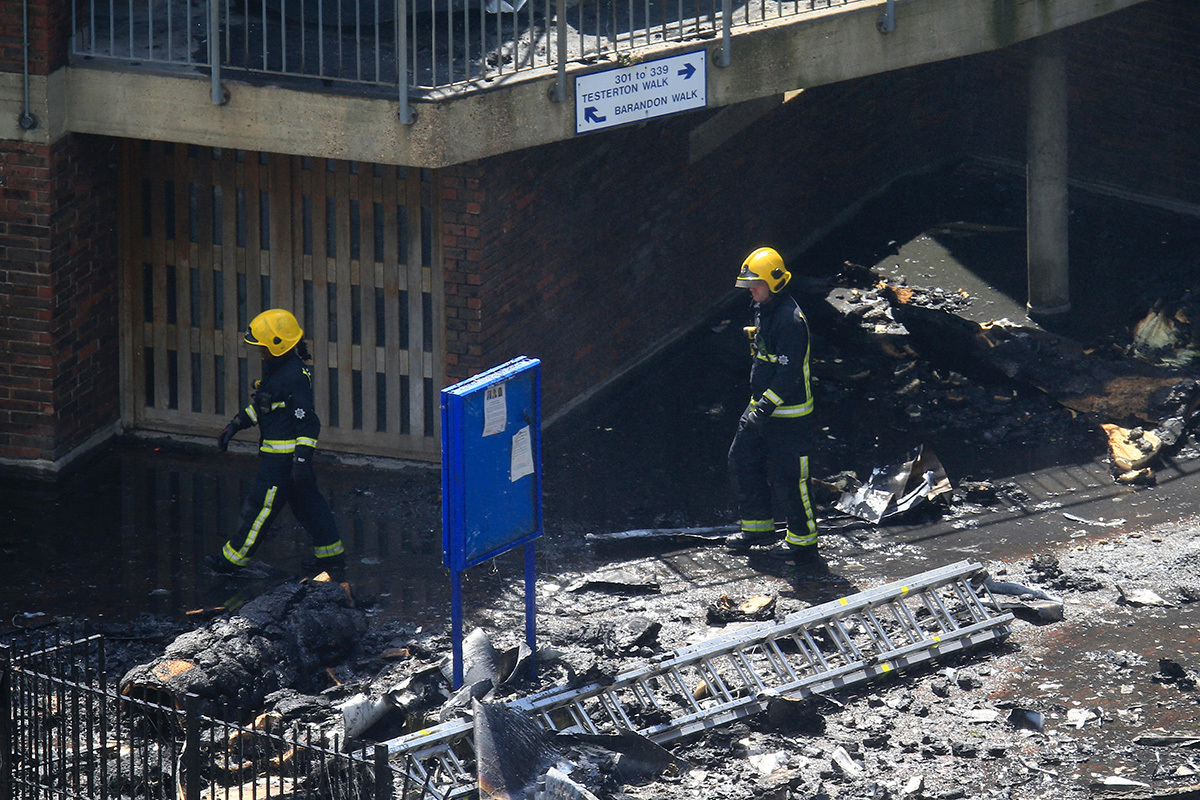
Professor Ed Galea is an internationally recognised expert on evacuation and founding director of the fire safety engineering group at the University of Greenwich. His view is that the UK remains too reliant on stay put.
“Stay put is fine as a Plan A,” he says. “But you have got to have a Plan B, and then a Plan C. Plan B should be the residents of the building evacuating themselves and then Plan C can be the fire service rescuing those still trapped.”
But the UK government is not pursuing this. Instead, its stance is that stay put remains a good strategy for the majority of buildings, and rather than moving away from it, we should fix the issues that make it problematic.
It has funded research, currently being carried out by the University of Central Lancashire, into how the fire services could manage an evacuation of a high rise, but results are still to come.
There is international precedent, though, for what fire services could do. Dr Michael Reick, a regional fire chief in Germany and former leader of the fire research laboratory at the University of Stuttgart, says: “There is always a chance that buildings fail catastrophically.”
“We [firefighters] have to prevent smoke spread and we have to be able to transport people through smoke-filled egress – even if they are disabled – at least to some extent. This will never be perfect and reliable, but there are good procedures in many countries.”
He explains that German fire services since decades ago make use of fans, smoke hoods and very frequently use smoke curtains to control the flow of smoke in a burning building and to protect egress routes because “the stairway is the most important room in a building on fire”.
“The key thing for me is to be able to control smoke spread, even with opening doors, missing doors or doors which have been destroyed by the fire. We have plenty of incident reports where it’s proven that this is quite often possible,” he says. “We would not tell people in general to stay in their apartment. If the staircase is smoke free and they want to leave the building, this is fine. If the staircase is smoke-filled, we might tell them to wait and use our ability to improve the situation and then get them through it.”
But Dr Reick is clear that this was not the fault of those present on the night. The plan should have been developed years in advance. “People in the UK blame the fire department for not having a Plan B. I can understand this. But this Plan B should have been prepared by fire engineers years before. These preparations did not happen,” he says.
The London Fire Brigade, at least, has made some progress in this regard, ordering a large amount of new equipment such as smoke hoods. Greater Manchester Fire and Rescue Service managed to safely evacuate The Cube in Bolton (pictured above), which suffered a huge fire in autumn 2019.
But across the UK, there is no evidence that fire services have the plans or equipment necessary to do what the teams in Germany do routinely: evacuate a tall building safely during an out-of-control fire.
“At the World Trade Center on 9/11, people who were knocked out of their chairs by the impact on the building got back up and started working”
Perhaps though, having seen what happened at Grenfell, people will just get out on their own, ignoring advice to stay put?
“I completely disagree with that,” says Professor Galea. “Traditionally, the problem with evacuation is getting people to respond: it’s called the response time. At the World Trade Center on 9/11, people who were knocked out of their chairs by the impact on the building got back up and started working.
“People who owned small companies spent time on the phone trying to find other premises, or went to the toilet even though they could see debris falling out of the window.
“9/11 turned the problem on its head. People were evacuating at the drop of a hat. It seemed that the response-time problem had gone away.
“But after a few years, the problem was back to where it was. People’s memories fade and their behaviour returns to normal. The same thing will happen with Grenfell.”
There is also the question of how people with mobility issues or other disabilities would be able to evacuate. At Grenfell, 15 of those killed had disabilities which hindered their ability to escape, meaning the fire killed 40% of the people in the building with such issues.
But the government recently rejected a proposal to require building owners to produce personal emergency evacuation plans, known as PEEPs, instead saying residents with disabilities should rely on staying put or awaiting rescue from the fire service.
This is a position which particularly concerns Professor Galea. “There aren’t enough firefighters to manage the evacuation of a whole building and rescue all the disabled residents and fight the fire at the same time.”
“PEEPs can allow as many disabled residents as possible to escape before they arrive, which leaves the fire service with a workable Plan C: to rescue those who are still trapped.”
He says the government was wrong to reject the idea that PEEPs could be carried out by a ‘buddy’ – a neighbour or relative – without the need for 24-hour staff in buildings.
“The concept of having buddies helping residents to evacuate, we did not invent that,” he says. “It happens in Canada, it happens in the US. They don’t call it PEEPs, but they talk about having friends and neighbours assist in the evacuation.”
His view is that stay put should be binned as a concept, and residents should instead simply be told to leave when the alarm sounds, with an alarm system installed that is either manually activated or triggered by an unusually large fire.
This view was echoed last week by another internationally respected fire expert, Professor Jose Torero, at the Grenfell Tower Inquiry. His report said it was “essential” that stay put is abandoned, because of the inability of current testing methods to prove that fire will not spread externally.
What is needed is a Plan B. “The fire service didn’t have a Plan B at Grenfell and the building didn’t have a Plan B, which is why I believe so many people died,” says Professor Galea.
Could it happen again?
So, five years on from Grenfell, we still have issues with dangerous cladding, faulty fire doors and a lack of an evacuation plan. The ingredients of that tragedy could still exist elsewhere.
But perhaps this approach – a straightforward mapping of the failures of Grenfell onto other buildings – is the wrong way of looking at it.
We were unprepared for Grenfell in the UK because our faith in the building regulations meant too few people recognised the risk of a major facade fire before it was too late.
We are now all too aware of this risk. Which risks are being overlooked now?
Ask fire safety experts this question, and it will not be long before you hear the phrase “timber”.
Over the past two decades, and particularly in the years since Grenfell, there has been a series of fires at buildings constructed using lightweight timber frames.
These blazes have been terrifying. In Crewe (pictured above) and west London (pictured below) in summer 2019, fire completely destroyed two large residential buildings and very nearly resulted in massive loss of life.
Despite these fires, timber-frame buildings are not subject to separate treatment under the building regulations. This means they will have stay put strategies, no alarms, no evacuation plans and often a single staircase, despite these measures being predicated on the fire performance of a concrete tower.
The method of construction, which involves a lightweight frame encased in plasterboard, is known to be vulnerable to fire. If the plasterboard is damaged, a blaze can enter the cavity and ignite the structure, meaning it burns inside walls and is near-impossible for the fire service to extinguish.
“It doesn’t make sense to me, to have a stay put plus a combustible structure,” says fire engineer Andrea White, managing director of consultancy AW Fire. “I’ve seen a report of one building where it was just nine minutes to 13 minutes before the fire was out of control and spreading through the structure.”
“It doesn’t make sense to me, to have a stay put plus a combustible structure”
However, the government does not appear to share these concerns.
“If you were to talk to government, they’d say we’ve had no deaths in timber frame,” says Ms White. “But there are all sorts of individual circumstances in each of these fires that have meant we haven’t had fatalities yet. You can’t rely on these to keep happening. I don’t necessarily think we’ll have another fire with 72 deaths, but there is absolutely a risk of some fatalities.”
Modular construction is another increasingly popular form of housebuilding. Individual flats are built in factories and then assembled on site, like a stack of boxes.
The potential problem with this is the scope to leave gaps between each box in which a fire could spread if it is not assembled and maintained properly.
This concerns Dr Jim Glockling, technical director at the Fire Protection Association. “I believe every single cavity barrier should be photographed when put in place. Cladding is easy to replace. It’s expensive, but easy. What if problems are deep in the 3D structure of the building?
“I see a future when a few of these buildings perform badly – usual story: fire spreads in building, building burns to the ground. If there is a loss of life, we will get every modular building coming under scrutiny, like we have with cladding systems, but this time it will be an impossible fix.”
There are other risks out there: the office blocks recently and sometimes shoddily converted to residential units, with limited oversight, in the past decade, or large-panel system tower blocks from the 1950s and 1960s. These are towers formed from large concrete blocks stacked on top of one another, which are known to perform poorly in fire, especially as they age, and carry the added risk of collapse.
What the government has done since Grenfell is focus narrowly on the specific problem in the tower (ACM in tall buildings), and miss the broader truth that the way to prevent a disaster is to introduce layers of protection, to provide the best chance against unforeseeable events.
Engineers describe this as redundancy: new systems which kick in if another one fails. In the UK, layers are more limited than in the rest of the world, with little focus on things such as fire suppression through sprinklers or evacuation. Instead, we still rely almost solely on the building’s compartmentation to protect life if a fire breaks out.
“Every country in the world is vulnerable to unknown risks,” explains one senior fire expert. “The problem is, when new technology appears, it goes to market before the safety is properly understood.
“A high-rise building is a very complex system. That means the safety has to be assured, so if one system does not operate perfectly, the other system picks up.
“For example, you provide an alternative route to evacuation just in case the first entrance becomes impassable; or a smoke ventilation system, or particularly strong compartmentation, or sprinklers waiting to sense heat.
“That’s the principle of redundancies. No layer is perfect, but the combination makes the danger of a fire drop really quickly. In the United Arab Emirates, they have more facade fires than any city on the planet, but they have many other layers, because of the levels of redundancy, and so they have very few deaths,” he says.
In the UK, this is not happening. There has been no major programme to retrofit sprinklers and, as discussed above, the government is continuing to resist calls for evacuation plans and the associated need for fire alarms and multiple exits.
“The problem in the UK is that we are relying only on compartmentation and the stay put strategy. This is one of the things where change is coming way too slowly. It’s taking 20 years to change something which could be changed in a couple of years,” the expert adds.
“My fear is that we could have another Grenfell, if not worse, tomorrow. Part of the problem we have is this widget mentality. You just fix the widgets that you see were broken and wait until the next widget breaks”
Taking all of this together, could Grenfell happen again? Views vary. “I don’t think that a Grenfell Tower fire would be repeated,” says one expert. “What happened in Grenfell was so many things went wrong, and that is highly unusual. That’s what makes it so tragic and relatively easy to avoid. You just need a few things to go right.”
Professor Galea is less confident. “My fear is that we could have another Grenfell, if not worse, tomorrow. Part of the problem we have is this widget mentality. You just fix the widgets that you see were broken and wait until the next widget breaks.
“But there will always be known unknowns, and unknown unknowns. That’s what makes having a Plan A, B and C for what to do when things go wrong so important.”
Others think another multi-fatality fire in a tower block is likely, but that it would not be as devastating as Grenfell Tower. Dr Jonathan Evans, chief executive of Ash & Lacy and a cladding expert, adds: “I don’t think we’ll see another large loss of life again like Grenfell unless a building has avoided remediation.
“It’s impossible to say, of course, whether other failures might happen, such as a collapse in a tall tower due to fire-induced structural failure. There are some quirky structures out there that might get past an assessment that shouldn’t, but they’re rare. However, I do think we’ll see further fires like those in 2019, where people won’t be so lucky.”
Danielle Gregory of Tower Blocks UK, the campaign group that supports social housing residents in dangerous buildings, is less positive. “We’re not in any doubt that there will be further preventable death in tower blocks. We think the government response has been inadequate and disjointed.”
One of the things that concerns her is that tenants still have little route to have their concerns listened to.
“In almost every case where there has been a serious fire, including Grenfell and the 2009 fire at Lakanal House, tenants have been raising concerns in the run-up to it,” she says. “These concerns are still being raised by many people who live in social housing, and they are still struggling to get their landlords to listen and act.”
Add all of this up, and we go to the fifth anniversary of the Grenfell Tower fire with the depressing reality that a repeat remains, at least, a possibility.
That is something no one would have accepted when they first saw those horrifying images five years ago.
Sign up for our fire safety newsletter
Already have an account? Click here to manage your newsletters
